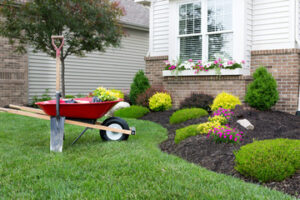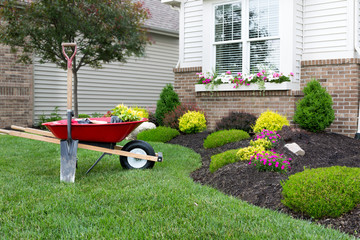Water features can be a beautiful addition to any landscape. From bird baths to koi ponds, they can be a great focal point when properly maintained.
Lines create interest in the landscape by drawing attention to a particular feature or creating pathways for the eye to follow. Consider scale and pacing when choosing plants, incorporating curves where possible, and keeping symmetry in mind. Visit https://www.landscaping-greensboro.com/ to learn more.
Landscaping involves creating an aesthetically pleasing outdoor space that includes plants, flowers, trees, and other natural elements. It can add value to your property and create a relaxing, comfortable environment for you and your family to enjoy. It also benefits the environment by reducing soil erosion, improving air quality, and providing habitats for wildlife.
Irrigation is the artificial application of water to land and crops using a variety of systems. It is an important part of agriculture as it provides the necessary water for crop growth when rainfall is not sufficient. It can be used for any type of plant including wheat and grasses, vegetables and fruits, and even golf courses and sports fields.
Water losses from irrigation can be minimized by minimizing surface runoff and deep percolation, maximizing soil organic matter, avoiding over-irrigation, reducing tillage, limiting fertilizer applications, using mulches, and other practices that promote healthy, well-developed root systems. It is also important to understand that the amount of water needed to grow a plant depends on the plant’s root structure, type, and size as well as climate conditions.
The best irrigation systems are designed to provide the right amount of water at the right time of day. To get the most out of your irrigation system, consider a smart controller that monitors weather and site-specific landscape information to create a more precise watering schedule. Smart controllers also allow you to adjust your schedule from your smartphone or tablet, saving you time and effort.
When selecting an irrigation system, consider initial installation costs, ongoing operational expenses, water savings, and long-term savings. Additionally, be sure to consider environmental factors such as local climate conditions and conservation regulations. Choosing the right irrigation system will help you minimize your impact on the environment while still providing the necessary water for your crops and lawn.
Planting Beds
Vegetable planting beds help gardeners grow healthier plants and increase the yield of their crops. Vegetable beds are usually built in a north/south orientation to maximize light exposure and can be made wider than traditional paths to allow gardeners to walk through them and push wheelbarrows with ease. Vegetable beds are often covered with mulch to suppress weed growth and keep the soil temperatures lower, especially in hot areas. It is important to make a sketch of the backyard dimensions before staking out vegetable beds. Beds should also be at least as deep as the gardener can reach to avoid compacting the soil when working in it.
Hardscaping
Hardscape is the non-living parts of your landscape design, and includes everything from pavers to retaining walls. This part of the design provides structure and balance to the outdoor space, contrasting with the soft, organic elements of landscaping like trees, flowers, and grass. In addition to adding visual interest, it can also serve functional purposes. For example, walkways and paths made of pavers make it easy to navigate the yard, while retaining walls prevent soil erosion and create distinct sections within the garden.
Hardscaping also adds value to the home, making it a great investment. The key to a successful hardscape is pairing it with the right softscape elements. This way, they complement each other and make the space look inviting and balanced. For example, a pergola with climbing plants is the perfect companion for a hardscape element like a patio. This combination makes for a beautiful and relaxing outdoor space, even in hot southern climates.
When choosing materials for your hardscape, consider their color, texture, and durability. Lighter-colored pavers, for example, will not absorb as much heat as darker ones. This means you will spend less time maintaining them and can enjoy your landscaping for longer. In addition, hardscaping is a great opportunity to express your personality through your choice of materials. For example, if you have a passion for music, you could incorporate musical notes into your design by using pavers shaped like guitars or drums.
Landscaping should never be viewed as an afterthought to your home’s exterior, but as an integral part of the overall design. A professional landscaper can help you create a seamless transition from the house to the outdoors, blending your hardscaping with the natural environment.
If you are considering a hardscaping project, be sure to discuss it with your contractor. They can help you prioritize your needs, provide options that fit your budget, and help you make the best choices for your yard. With careful planning, you can ensure that your hardscaping project is a success and will last for years to come. For more information on landscaping services, contact Cutters Landscaping today.
Lighting
Landscape lighting is one of the most powerful tools you have for establishing focalization. Without it, your garden or yard can devolve into a sprawling collection of plants and hardscape features with no clear purpose or direction. Focalization draws the eye toward those areas of your property you wish to emphasize, either by highlighting landscape architecture such as structures like sheds or arbors, or by highlighting particular types of plants that stand out for their beauty or unique attributes. Hinkley landscape lighting offers a wide selection of styles and options to meet your lighting needs. Click here to learn more.
